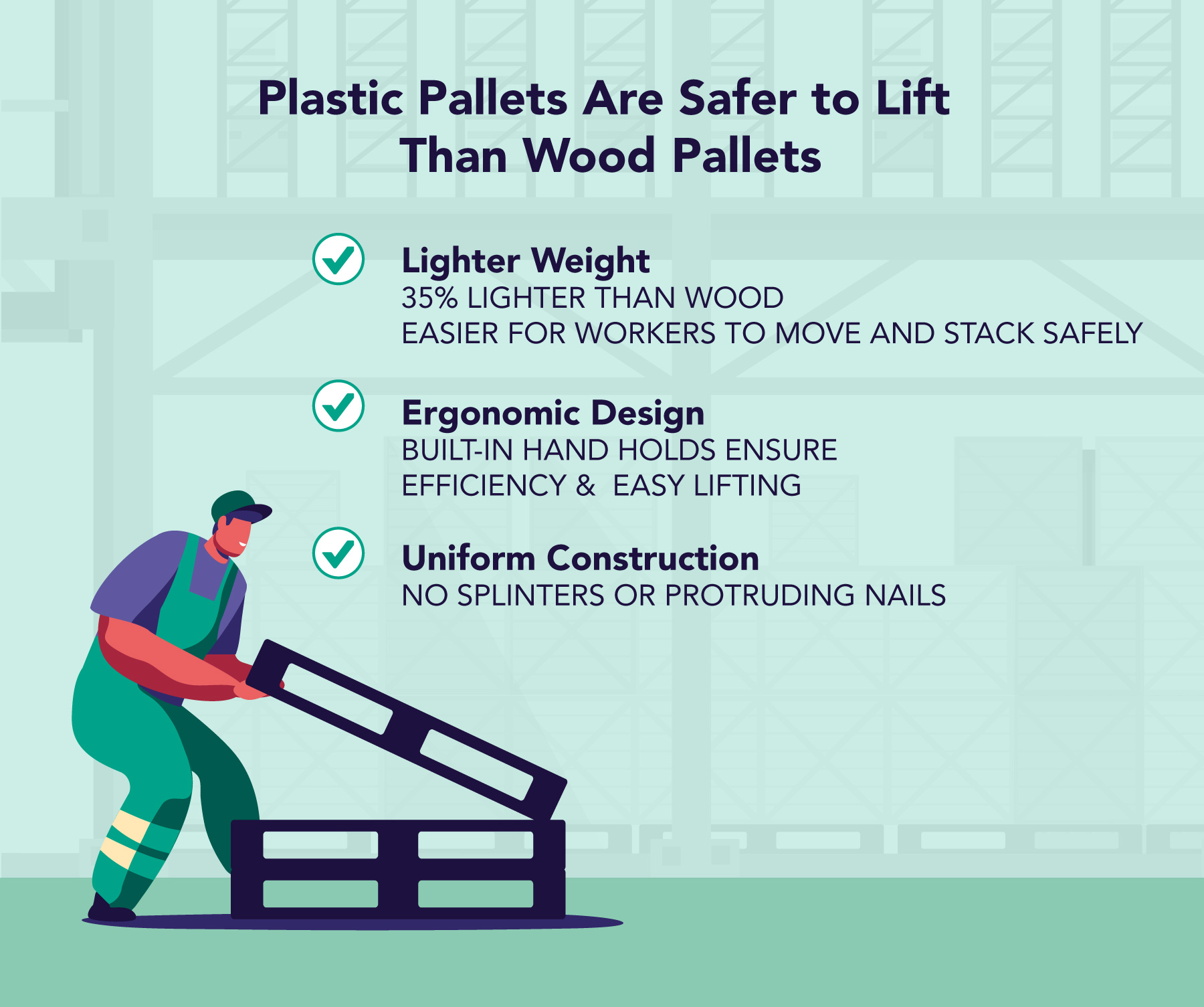How to Properly Lift a Pallet
Employees working in warehouses and manufacturing face a heightened risk of sustaining injuries. In 2021, the U.S. Bureau of Labor Statistics identified manufacturing and warehousing among the top five private sectors with the highest number of reported nonfatal work-related injuries and illnesses.
A typical reusable wood block pallet weighs between 75 and 80 pounds, and according to recommendations from the Occupational Safety and Health Administration (OSHA) and the National Institute for Occupational Safety and Health (NIOSH), it should ideally be lifted by two people. Improper manual lifting of heavy objects like wood block pallets can result in various shoulder and back injuries, including muscle strain, disc injury, or even fractures. Mishandling pallets can jeopardize the safety of workers, underscoring the importance of educating employees on the proper lifting techniques for pallets as a crucial step towards reducing workplace injuries.
In warehouses and manufacturing facilities, employees frequently engage in repetitive bending movements during their shifts. This bending is necessary for stacking or unstacking empty pallets and conducting inspections. However, such actions can impose considerable strain on the back muscles responsible for supporting both the upper body and the weight being lifted. The repetitive forward bending and waist twisting required to lift heavy wood pallets can lead to lower back, spine, or shoulder muscle sprains.
Therefore, the answer to how to properly lift a pallet lies in a few ergonomic principles. Maintaining a correct posture, straight torso, and relaxed shoulders while lifting helps prevent the back and shoulder muscles from becoming strained. To minimize injuries while manually stacking a wood pallet or lifting a pallet from a stack, workers should practice smart lifting techniques:
- Use the feet as base support: Placing feet shoulder-width apart provides a wide base of support while lifting heavy loads and discourages back lifting.
- Keep the upper back straight: A straight spine and a neutral posture help to avoid back injuries. Engaging your upper thighs and knees as support while lifting a pallet instead of bending forward reduces the risk of injury.
- Bend at the hips and knees, or squat down: Squatting down or bending the hips and knees puts less stress on the back while lifting. When two workers are unstacking wood pallets, it is safest to hold a pallet at the corners and lower it down to the floor by bending the knees and keeping the feet apart.
- Hold the load closer to the body: It requires less effort to lift loads if they are kept close to the body at power zone height (mid-thigh to mid-chest). One technique that can help is to tip pallets to a standing position while keeping a corner or edge of the pallet on the floor to support some of the pallet’s weight before lifting the entire pallet.
While these tips can help employees learn how to properly lift a pallet, before handling wood pallets it is important to first ensure that certain key safety considerations are in place:
- Pallets have been inspected and do not have sharp splinters, rough edges, or protruding nails.
- Pallets are not leaned on their sides and are stacked evenly no more than six feet high.
- Weight is distributed evenly to avoid injuries while lifting.
- Pallet platforms move freely and do not snag under load.
- Workers lifting pallets are using personal protective equipment (PPE) including gloves and steel-toed boots.
Safety issues with wood pallets, such as broken or split boards, protruding splinters, or missing fasteners, can be easily identified during a pallet inspection. One way to streamline your pallet inspection process and reduce the opportunity for employee injury during pallet handling is to switch to a safer, more durable type of pallet.
Why Plastic Pallets Are Easier to Lift Than Wood Pallets
Plastic pallets are redefining shipping platforms worldwide. Unlike wood pallets, high-quality plastic pallets increase pallet handling safety as they are lighter, more durable, and sturdier than wood. There are several key reasons why plastic pallets are easier and safer to lift compared to wood pallets:
- Lighter weight: High-quality plastic pallets weigh less than 50 pounds, making them around 35 percent lighter than wood block pallets.
- Ergonomic design: Inadequate handholds make manual lifting of wood pallets more difficult and increase the risk of contact stress. Built-in handholds on plastic pallets ensure ergonomic efficiency and easy lifting.
- Uniform construction: Plastic pallets have uniform dimensions, rounded edges, and smooth surfaces. There are no risks of injury from splinters or protruding nails while handling plastic pallets.
The handling benefits of plastic pallets also help to speed up throughput at warehouses and distribution centers by making loading and unloading easier. This ultimately increases efficiency in the supply chain, reducing overall costs.
While the method to properly lift a pallet is the same for both plastic and wood platforms, plastic shipping pallets provide a safer and more reliable alternative to wood. Switching to plastic pallets helps minimize warehouse injuries, lowering your total cost of business (TCOB) over time.
Properly lifting a pallet is a skill that not only enhances workplace safety but also improves productivity by preventing injuries and damaged goods. Taking precautions and using a lighter, more durable pallet not only protects employees but also promotes a culture of safety in the workplace, leading to a more productive and accident-free environment for everyone.
Companies looking to make the switch to plastic pallets should consider iGPS plastic pallets for all their shipping needs. Our lightweight, recyclable plastic pallets incorporate RFID technology, making them traceable throughout a supply chain. For more information, contact us at 1-800-884-0225, email a specialist at switch@igps.net, or visit our contact page.




